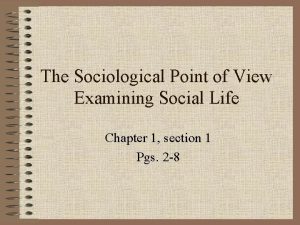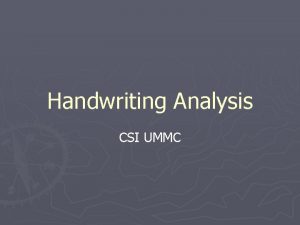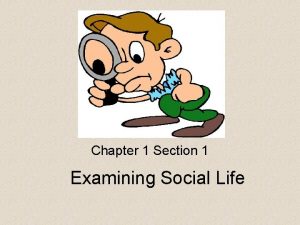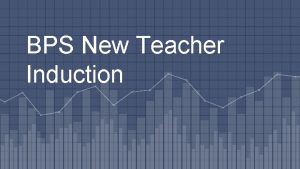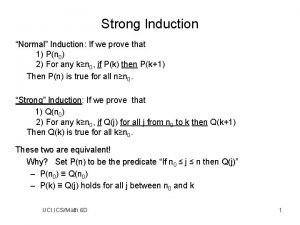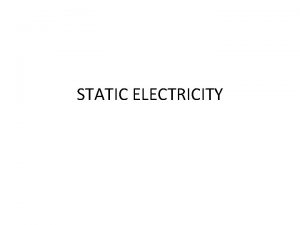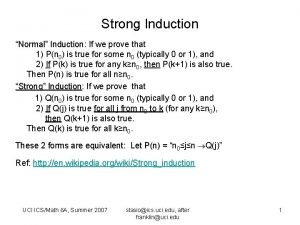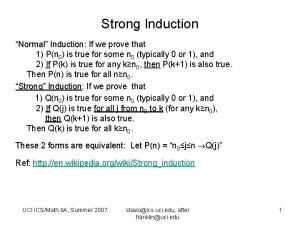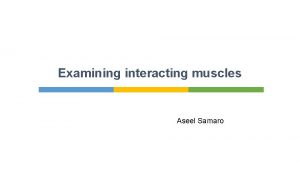Examining the Effects of New Teacher Induction MARJORIE


















- Slides: 18

Examining the Effects of New Teacher Induction MARJORIE E. WECHSLER DANIEL C. HUMPHREY

Methodology Teacher and mentor surveys Case studies Retention analysis Student achievement analysis

Frequency of Interactions with Mentors 100 Percent of teachers 80 60 40 23 20 23 17 13 15 10 0 Once or a few times a year Once per month A few times per month Once per week Several times per week Daily

Frequency of Mentoring Activities Discussed instructional problems 27 21 23 Discussed specific students Shared materials 20 Discussed assessment data 18 17 13 10 Observed teaching 16 10 Developed professional growth plan 16 10 Planned lessons 10 Analyzed student work 7 8 Observed mentor's classroom 4 Demonstrated lessons 4 0 3 4 3 20 40 60 Percent of teachers About monthly At least weekly 80 100

Other Induction Supports New teacher workshops, seminars, and classes 35 Professional network 19 15 Principal meetings 0 1 3 2 20 40 60 Percent of teachers About monthly At least weekly 80 100

Teacher Professional Community Consult about instructional issues 28 Work together to develop lessons 51 25 Discuss assessment data 26 29 Analyze student work 15 21 Observe each other’s classrooms 8 0 15 4 20 40 60 Percent of teachers About monthly At least weekly 80 100

Predicted Mean of Teacher Self-Efficacy 4 3. 52 3. 33 3. 38 3. 24 3. 11 3. 16 3. 27 3. 21 3 2 1 School context** Intensity of mentoring * Strong Focus on instruction ** Weak Variety of induction activities**

Predicted Mean of Teacher Growth 4 3. 37 3. 10 3. 09 3 2. 80 2. 54 2. 22 2. 18 2 1. 65 1 School context** Intensity of mentoring ** Strong Focus on instruction ** Weak Variety of induction activities**

Summary of Significant Predictors by Outcome Teacher Self. Efficacy Reported Growth District Retention School Context X X Intensity of Mentoring X X Focus on Instruction X X Other Induction Activities X X

Mentor Selection Requirements Minimum number of years teaching 41 40 Mentor training program prior to selection Formal application 30 22 Recommendation 13 Classroom observation 13 Interview 0 20 40 Percent of mentors 60 80 100

Mentor Training and Ongoing Support

Mentor Accountability Requirements Log of mentoring hours 21 Summaries of mentoring meetings 14 18 Summary of mentoring goals 10 Formative evaluation 8 0 10 1 1 20 40 60 Percent of mentors About monthly At least weekly 80 100

Mean Intensity of Mentoring by Program Lever 4 3. 22 3. 14 3 3. 12 2. 87 2. 80 2 1 Mentor selection Mentor training and support High Low Mentor accountability

Mean Focus on Instruction by Program Lever 4 3. 14 3. 08 3 3. 00 2. 82 2. 81 2. 79 2 1 Mentor selection Mentor training and support High Low Mentor accountability

The Elusive Search for Student Achievement Gains Comparison groups Time Measurement tools Accuracy of value added methods

Teacher Retention 6% laid off Excluding lay-offs 82% retained in same school 84% retained in same district Context matters Teachers in strong school contexts 4. 65 times more likely to be retained in the same school as teachers in weak school contexts

Role of School Context Previous reports Interaction of context and induction programs Micro-contexts

Reinventing Induction
 The comparative study of past and present cultures
The comparative study of past and present cultures Two people can have identical handwriting.
Two people can have identical handwriting. Examining social life
Examining social life Data preparing exploring examining and displaying
Data preparing exploring examining and displaying Examining social life practice
Examining social life practice Three principles of acquiring spiritual knowledge
Three principles of acquiring spiritual knowledge What conclusions can you make from examining the geochart?
What conclusions can you make from examining the geochart? Marjorie spiegel
Marjorie spiegel Marjorie schick designs
Marjorie schick designs Marjorie lejeune
Marjorie lejeune Marjorie lejeune
Marjorie lejeune Phlebotomy basics
Phlebotomy basics Marjorie pajaron
Marjorie pajaron Marjorie ferguson
Marjorie ferguson Marjorie michele
Marjorie michele Oque é digrafos
Oque é digrafos Definition of ph
Definition of ph Marjorie pajaron
Marjorie pajaron Marjorie pajaron
Marjorie pajaron
